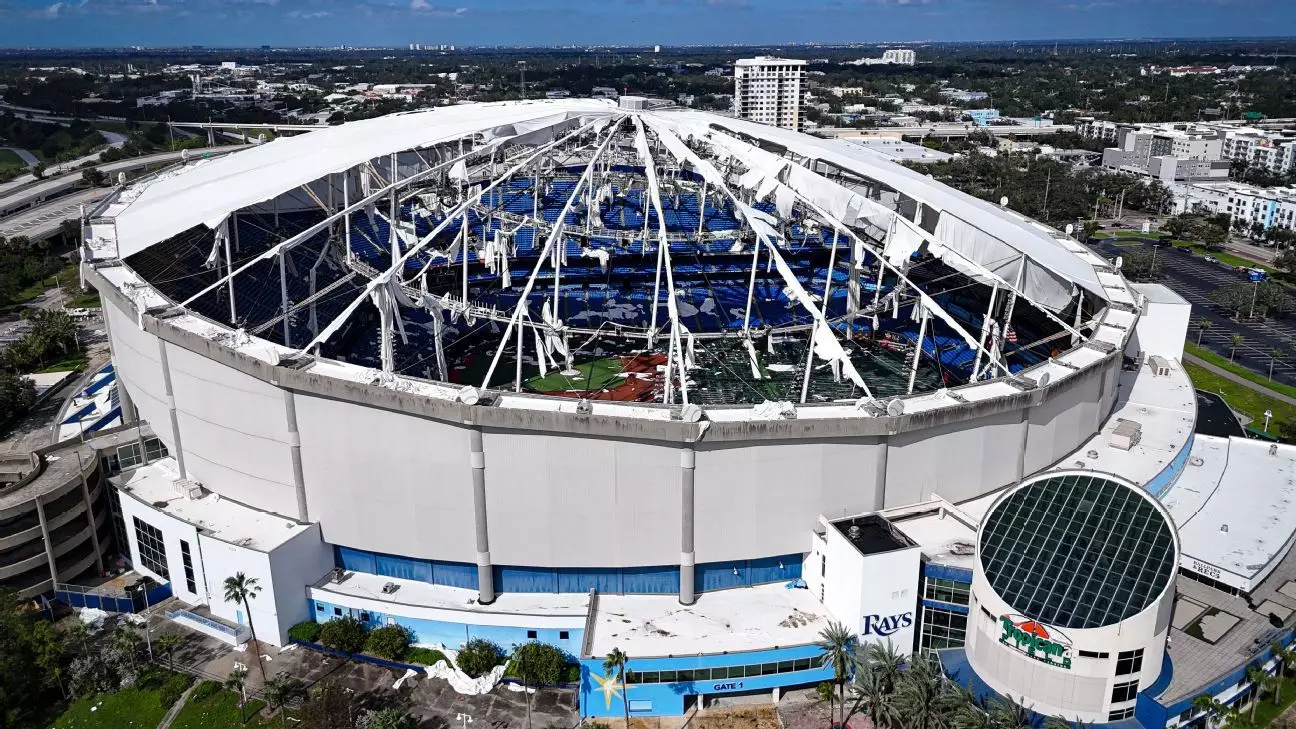In the wake of Hurricane Milton’s recent onslaught, the intricate evaluation of Tropicana Field’s structural integrity has garnered significant attention. A comprehensive report spanning 412 pages, provided by the St. Petersburg city officials, assuages initial fears as it confirms that the Tampa Bay Rays‘ home remains structurally sound. The assessment’s bottom line reveals that reparative measures could amount to roughly $55.7 million to restore the facility prior to the 2026 season. While the core structure stands resilient, the prominent fabric roof did not fare as well. Analysts report that the storm resulted in the failure of 18 out of 24 fabric panels, which poses a critical challenge for the stadium’s operational prospects.
The Impact of Hurricane Milton on the Trop’s Infrastructure
As the report delineates the extent of the damage, it recognizes not only the compromised roof but also interior damages stemming from rainwater intrusion and other storm-induced factors. The insights provided by Hennessy Construction Services portray a blend of caution and careful optimism regarding the stadium’s future. Tropicana Field, which opened its doors in 1990 and became the Rays‘ home turf in 1998, has weathered numerous storms over the years, yet the fallout from Hurricane Milton demands a reconsideration of its operational viability.
Following the damage assessment, the Rays find themselves at a crossroads, as the stadium will be non-operational for the upcoming season. This predicament compels the organization to seek temporary relocation options. Major League Baseball (MLB) encourages the franchise to remain in proximity to its established fan base, exploring potential venues like nearby spring training facilities. Notably, cities such as Clearwater, Tampa, and Lakeland could house the team during their transitional phase, yet these fields are more accustomed to hosting minor league games and would necessitate careful logistical planning.
The proposed budget for the repairs raises important financial questions. The city council of St. Petersburg is set to discuss the report and the associated costs at their upcoming meeting on November 21. Community members, including council member Brandi Gabbard, express the need for a balanced approach, given the multitude of demands facing the city. The reality is stark: while the Rays are beloved by many, the pressing needs of a city experiencing the aftermath of two major hurricanes cannot be underestimated.
Recent decisions surrounding the fiscal allocation for repairs to the ballpark reflect this tension, as the council recently approved an expenditure of $6.5 million aimed at safeguarding the Trop from further deterioration. These funds focus on waterproofing critical areas, but they open the door to discussions about the long-term viability of the current structure, especially with the looming plans for a new $1.3 billion ballpark slated for completion by 2028.
The freshly proposed ballpark, envisioned as part of a larger $6.5 billion redevelopment initiative, is designed not only to house the Rays but to revitalize a historically significant area. The Historic Gas Plant District project aims to cultivate affordable housing, a Black history museum, retail spaces, and dining experiences, contributing to a holistic revitalization of a community that once thrived before displacement.
While the grand vision for this new development is commendable, the journey to its realization may face unexpected hurdles. The city’s and Pinellas County’s financial frameworks could encounter a reassessment due to recovery costs from recent hurricanes, perhaps influencing the approach to both the Tropicana Field repairs and the ambitious new stadium plans. As taxpayers‘ dollars may need to cover considerable gaps in funding—especially given the high deductible on the city’s insurance claim—the conversation surrounding community prioritization and fiscal responsibility will remain paramount.
The future of Tropicana Field amidst the echoes of Hurricane Milton underscores a complex interplay of structural assessments, community needs, and financial realities. As the Rays seek a temporary new home for the 2026 season and the city grapples with broader economic implications, the evolving narrative will shape not only the fate of the team but also the revitalization efforts impacting the community at large. Ultimately, the city council’s deliberations in the coming weeks could set the stage for an enduring legacy, bridging past afflictions with future possibilities.


Napsat komentář